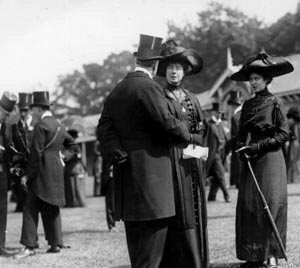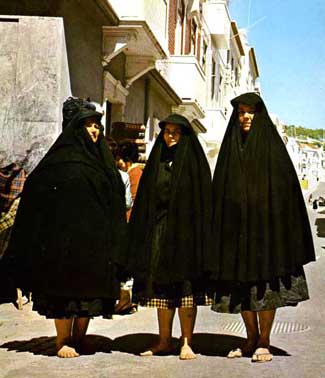 |
Formation of Children
Catholic Funeral Etiquette - Part III
The Mourning Period
Marian T. Horvat, Ph.D.
In days past, the rules of behavior for mourning were well known and rigorously followed. Depending on the proximity of relation to the deceased, the person wore certain types of mourning clothing for certain lengths of time.
These were the wise rules for social behavior while mourning, based on a Catholic etiquette book written in 1962:

A day of national mourning was declared for President John Kennedy. His widow wore traditional black |
• One in mourning does not go to large public functions, balls or dinner parties. He does not dine out in restaurants or go to parties. He also does not host parties or social functions in his home during the mourning period.
• He may dine with friends in his home. He may continue such sports as he has always played, but his costume should be dark-colored and suitable to the game he is playing.
• A widow or widower should not accept or offer attentions to the opposite sex for a year. If this rule is disregarded, all mourning garb should be left off and all pretenses of being withdrawn from society dropped.
• Children who have lost a parent may continue to take part in activities such as recitals, sodality and church group meetings, sports events, music lessons and orchestra. However, they do not go to dances, teas, receptions, and dinner or birthday parties for friends. They should observe at least a three-month mourning period.
In my view, these are laudable customs that should be revived in Catholic homes.
Duration of mourning
By the 19th century, mourning was distinguished by three periods:
• Heavy or deep mourning: an all-black costume and no jewelry with colored stones. All white is also full mourning and may be worn at necessary social functions or in the country.
• Half mourning: clothing is black with white touches, or white with black touches.
• Light or second mourning: Clothing characterized by black and white mixtures, grey, mauve, violet, lavender, and similar colors, including patterned fabric.
• Children under age 12, instead of wearing black, wore white in the summer and grey in the winter, both with black trim. By the 20th century, children under age 14 generally did not wear mourning clothing.

The Black Ascot of 1910: All who attended wore black mourning for King Edward VII |
As for the periods of mourning times, these were the old rules from Catholic Europe:
For a widow: one year of heavy mourning, followed by six months of half mourning, and six months of light mourning, for a total of two years. If a young widow meets someone whom she considers could be a proper suitor after the first year, she is not required to remain in mourning.
For a widower: one year of heavy mourning, six months of light, for a total of 18 months
For the death of parents and children: six months of heavy mourning, six months of half, three months of light, for a total of 15 months.
For the death of grandparents and siblings: four months of heavy mourning, four months of light: for a total of 8 months
For the death of aunts and uncles, or nieces and nephews: one month of full mourning, one month of light, for a total of two months.
These standards were strictly maintained through the Civil War period and even into the beginning of the 20th century in higher society and good families. Many persons, however, began to adopt the more practical custom of simply wearing dark clothing to express their mourning. The periods of time were also shortened to these general guidelines:
For a spouse - a year and a day;
For a parent or child – six months;
For a grandparent or sibling - three months.

The widows of the fishermen in Nazare, Portugal, in their distinctive black capes |
Today you can still find widows and mothers who wear mourning or half-mourning for a year. Widowers also may wear mourning for a year, but usually only on formal occasions and not in the business place. Others, including adult brothers and sisters, seldom wear mourning following the funeral.
With the invasion of the Cultural Revolution - with the practical abolition of the suit and tie as daily apparel for men and a corresponding loss of fine tailleur for women, mourning became much more difficult to maintain. Indeed, how can a person wearing sports shirts, blue-jeans or Bermudas demonstrate that he or she is mourning some relative? Would the solution be to wear black? In principle, yes, but another problem arises with the modern day “gothic” wave, which embraces the almost exclusive wearing of black and certainly tends toward Satanism.
Therefore, it becomes difficult to know what to recommend for those who would like to wear mourning clothes today. The only solution I can envisage is to recommend that men return to their suits and ties - at least during the mourning period - and that women wear modest classic dresses and skirts.
In conclusion, some traditional minded people – like myself – still hold that it is good to observe mitigated forms of the rules for the mourning period. Since no strict laws of etiquette prevail today and concrete situations vary so greatly, it seems legitimate that persons and families should adopt mourning periods and wear clothes appropriate to their circumstances.
The mourning of Queens

Following the medieval tradition, Queen Fabiola of Belgium, center, wore white at King Baudouin's funeral |
Mourning in the United States generally followed the English forms. By the 19th century, mourning had become a highly structured social ritual that reached its apex in the reign of Queen Victoria, who wore mourning clothes for forty years, until her own death in January of 1901.
Queen Victoria was certainly not the first royal woman to adopt perpetual mourning. Empress Maria Theresa of Austria cut her hair short after her husband Franz I died, and wore black for the rest of her life. Catherine de Medici also went into black and wore it until she died in mourning for her husband, Henri II of France. Marianna of Spain cut her hair and wore black religious garb after her husband, Philip IV, died, even though she fully participated in government as regent for her son, Carlos II. This was very much a Spanish tradition for royal women.
To this day, in traditional regions of Mexico, Portugal, Spain, Italy and Greece widows maintain the custom of wearing black for the rest of their lives.

Posted August 6, 2008

Related Topics of Interest
 Funeral Etiquette - I Funeral Etiquette - I
 Courtesies to the Family of the Deceased - II Courtesies to the Family of the Deceased - II
 Requiescant in Pace... Requiescant in Pace...
 The Blessing - Manual of Civility The Blessing - Manual of Civility
 Something Fishy about the Death of John Paul II Something Fishy about the Death of John Paul II
 The Novissima - the Four Last Things The Novissima - the Four Last Things
 Americans Think Hell Exists, But No One Goes There Americans Think Hell Exists, But No One Goes There
 Importance of the Devotion to St. Joseph Importance of the Devotion to St. Joseph
 A Black-out on Black A Black-out on Black

Related Works of Interest
|
|
Formation | Cultural | Home | Books | CDs | Search | Contact Us | Donate

© 2002- Tradition in Action, Inc. All Rights Reserved
|
 |
|